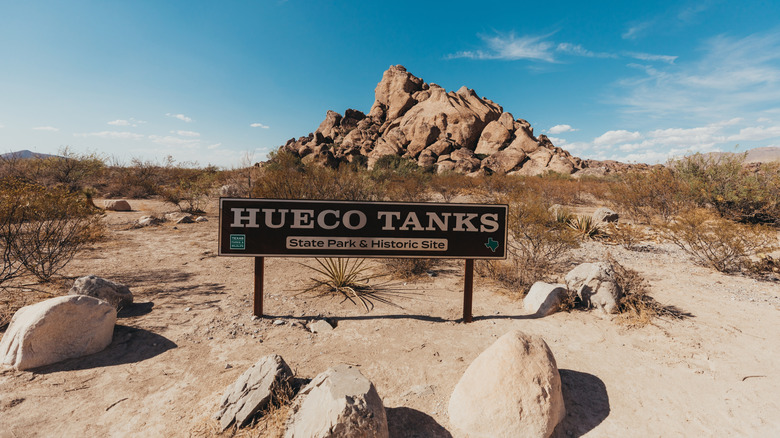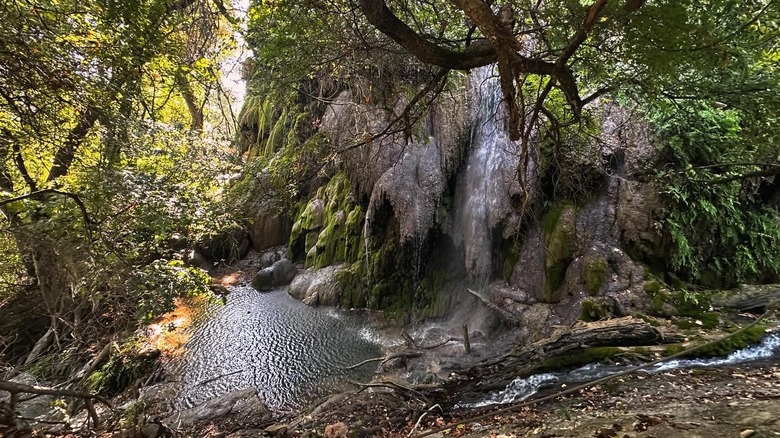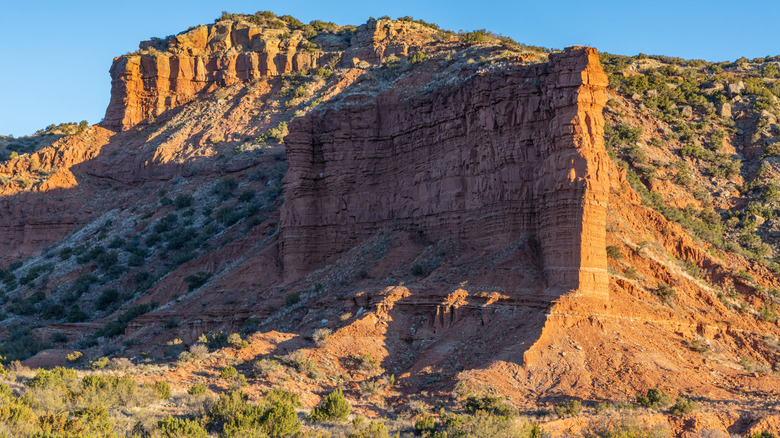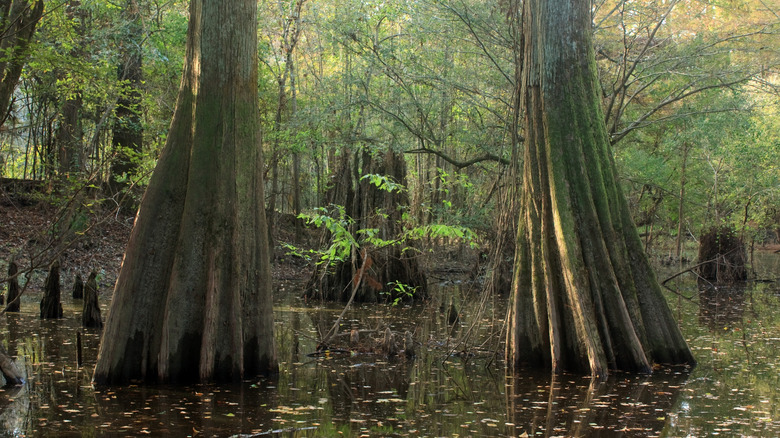These Underrated Texas State Parks Offer Stunning Scenery Without The Crowds
If someone were to ask you to think about Texas, the first images that may come to mind would probably be vast stretches of desert highways, cowboys in big hats riding off into the sunset, adventuring through popular spots like the towering cliffs of Big Bend, and, of course, chowing down on some mouth-watering BBQ. The great state of Texas is home to 89 state parks making it somewhat difficult to decide which is best for your ideal vacation. While many of the more popular Texas state parks are definitely worth a visit due to their iconic rugged beauty, their popularity can make them feel overcrowded. (Many bring in upwards of 300,000 annual visitors.) If you're looking for an escape into nature without the intense crowds, why not try a visit to one of Texas' lesser-known state parks?
While these parks may not make the headlines or the top 10 lists, they provide solitude, serenity, and more personal experiences with nature than many of their more popular counterparts. Whether you're a seasoned hiker looking to spend some time in unspoiled terrain, a camper seeking a peaceful escape under the stars, or a road-tripper seeking a unique detour, a visit to one of these parks offers the perfect escape into the great outdoors. From roaring waterfalls and hidden swimming holes to rugged canyons and lush forests, here are five underrated Texas state parks for your next adventure.
Hueco Tanks State Park and Historic Site
First on the list is a unique state park that has provided sanctuary to many different living things for thousands of years. Nestled into the Chihuahuan Desert just 40 miles east of El Paso, Hueco Tanks State Park and Historic Site is a place where travelers can explore prehistoric art, geological wonders, and cultural reverence. Historic evidence of humans in the area goes back 10,000 years, which can be seen in the over 3,000 ancient pictographs and petroglyphs — also known as rock paintings and carvings.
The park gets its name from the natural rock basins found here called "huecos," Spanish for hollows or cracks. They collect rainwater, providing a life-sustaining resource for ancient peoples and creatures in this literal desert. Because of its historical significance, visiting Hueco Tanks is not like visiting your average state park — exploring this area requires a bit more pre-planning.
While visitors are welcome to hike and rock climb through parts of the park on their own with a permit reservation (and only 70 people permitted to the area at a time), guided tours are necessary to visit the West Mountain, East Mountain, and East Spur areas. Per the park's website, three tours with different routes and difficulty are offered Wednesday through Sunday if a guide is available. Rangers and volunteers also lead pictograph, hiking, birding, and rock climbing tours. Tours are $5 for adults and $2 for children, in addition to the park entry fee, which is $7 for adults, and free for children 12 and under. Visitors must also watch an orientation video before camping in one of the 20 available sites or visiting the self-guided area.
Colorado Bend State Park
One of the best Texas parks for adventure, Colorado Bend State Park is a natural oasis just a few hours' drive from Austin. Home to 5,300 acres of natural splendor — including 35 hiking and biking trails, a 70-foot-tall waterfall, swimming holes, bass fishing, boating, and hundreds of caves ripe for exploration — this park has everything adventure lovers could ever want. Though the park has numerous hiking and biking trails, two remain more popular than the rest.
First, no trip to Colorado Bend would be complete without visiting the stunning Gorman Falls, one of the most breathtaking waterfalls in Texas. The hike is a roughly 3-mile round-trip trek through flat rocky terrain that descends along a steep slick rock with chains to help keep you upright. Although swimming is not allowed here, visitors can marvel at the beauty of the thunderous waterfall from a viewing deck. The other popular hike in the park is the Spicewood Springs Trail, a moderate to difficult 3.7-mile loop hike with multiple spring-fed pools and shallow waterfalls to wade or swim in.
Aside from strolling the different trails, visitors can also get down and dirty and explore some primitive caves with Nichols Outdoor Adventures, an independent tour operator within the park. Exploring a section an extensive cave system, adventure-seekers will spot ancient stalactites, stalagmites, and flowstones and learn more about its unique ecosystem. The park also offers camping options for those looking to spend more time in the park, including drive-up sites, walk-in tent sites, and primitive hike-in sites. Admission to the park is 5 USD for adults, while kids 12 and under are free.
Caprock Canyons State Park & Trailway
Looking for an adventure filled with exploring steep and colorful canyons and bluffs? Look no further than Caprock Canyons State Park & Trailway. Located in the Texas panhandle, about two hours from Amarillo, this larger-than-life park is the perfect spot for those seeking quality time with the great outdoors. The canyon was formed by streams flowing through the Caprock Escarpment millions of years ago. You can see the red, orange, and white layers in the rocks; each color represents a different geologic age. The park's landscape mainly consists of prairie grasses surrounded by towering canyon walls. Visitors to this expanse of land can hike through 90 miles of trails, see bison roaming the great plains, ride horses, camp, geocache, or take a boat ride along Lake Theo. Visitors can even borrow a fishing pole from the park's headquarters (but have to find their own worms).
The park is also home to the Caprock Canyon Trailway, allowing visitors to explore a 64-mile-long route fit for hikers, bikers, and equestrian trail riders. Alternatively, explore from the comfort of your car along the 5.5-mile scenic drive that runs through the park, offering stunning views and numerous overlooks to stop at and take in the views. Admission to the park is $5 for visitors 12 years and older, and free for youths. Those looking to spend more time in the park can camp at one of the 104 sites available — including primitive sites and some with access to electricity and water. The campground also offers larger sites for those coming with big groups.
Fort Boggy State Park
Halfway between Houston and Dallas sits Fort Boggy State Park, boasting over 1,800 acres of land prime for exploration. Although the park is smaller than some of its more popular counterparts, its small stature is part of its charm. In an interview with Texas Highways, J.D. Miller, the park's superintendent, explained the benefits of it being less crowded and more off-the-beaten-track. "We are such a small park ... people drive past and don't even know we are here, but once we get them in the gate, we see them over and over." So what makes Fort Boggy so unique?
For one, its tranquility. Visitors can go hiking or biking through the park's 3.5 miles of trails — including the 1.5-mile Lake Trail or the two-mile Nature Trail that winds its way through the woods — and seek out different critters like deer, foxes, beavers, and a variety of various birds. Admire the different types of trees, including native river birch, and take in the serenity of Sullivan Lake, with 15 acres of opportunity to swim, canoe, kayak, or fish for bass, catfish, sunfish, and rainbow trout. The park allows visitors to bring their own powered and non-powered boats, but rentals are also available. Admission to the park is $3 for people over 13 and free for younger visitors. Stay the night in one of the five cabins (which have many amenities, but you must bring your own sheets and pillows) or rough it at one of the primitive hike-in sites about a mile from the trailhead.
Village Creek State Park
Located in Lumberton on the edge of Big Thicket National Preserve (a must-visit destination for water adventures), Village Creek State Park is not only the gateway to Big Thicket but also offers visitors the chance to explore over 2,000 acres of stunning land. The diverse ecosystems within the park's bounds include cypress swamps, dense pine forests, and sandy woodlands. The park is also home to one of only a few free-flowing creeks in Texas, as well as the Village Creek Paddling Trail — a 21-mile trail where explorers can hop in a canoe and spend the day floating and fishing. The park loans out fishing equipment and doesn't require a fishing license.
Birders will be delighted to know that Village Creek is home to over 200 different species of birds, such as wood ducks, egrets, herons, woodpeckers, and owls. For those who enjoy hiking and biking, the park offers 8 miles of trails, including Lil' Paws Nature Trail for the younger adventurers or the 2.4-mile Water Oak Trail. Here, explorers will venture past cypress and pine and make their way down to bottomland swamps. While alligators are rare to spot at Village Creek, they do live in the area.
Admission to the park is $4 for people aged 13 and up, while youths can visit for free. The park offers eight campsites with electricity, eight primitive hike-in sites, and one group site (that can fit up to 50 people). If you're feeling fancy, there is also one charming cabin with modern comforts that sleeps up to six. Even with all the fun to be had here, Village Creek State Park still remains under the radar, providing its visitors with a serene and uncrowded natural retreat.





